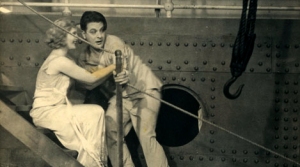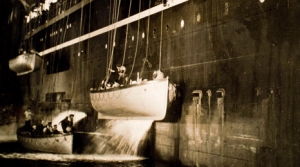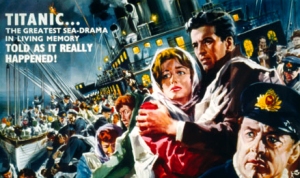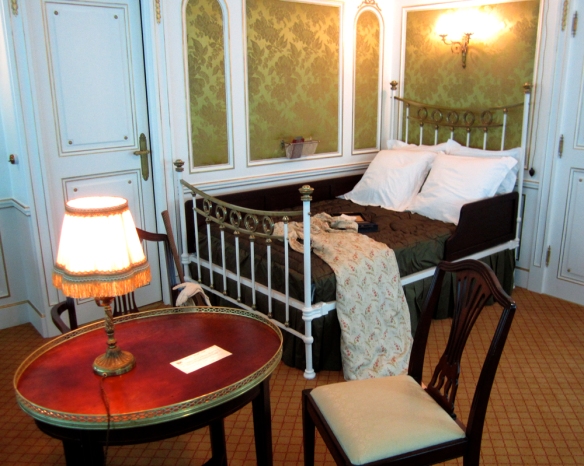Here’s the full schedule for the Titanic season organised by the British Film Institute.
March 20 6.20pm NFT1, BFI Southbank
Titanic (TV miniseries, 2012)
A special preview screening of episode 1 of Julian Fellowes’ eagerly awaited four-part miniseries, plus a Q&A session featuring Fellowes, director Jon Jones, producers Nigel Stafford-Clark and Simon Vaughan, and cast members.
* * * * * * * *
April 5 onwards BFI Imax
James Cameron’s Titanic (USA, 2012)
The new 3D version of James Cameron’s 1997 blockbuster.
* * * * * * * *
 April 11 6.20pm NFT3, BFI Southbank
April 11 6.20pm NFT3, BFI Southbank
Hitchcock’s Titanic Project
A talk by Professor Charles Barr. Alfred Hitchcock was originally scheduled to make his Hollywood directorial debut with a Titanic movie in 1939. He called it a “marvellously dramatic subject for a motion picture”, but the film was never made. Professor Barr will show a sequence edited from his other work to illustrate how it might have looked.
* * * * * * * *
 April 11 8.40pm NFT3, BFI Southbank, and April 15 4pm NFT2, BFI Southbank
April 11 8.40pm NFT3, BFI Southbank, and April 15 4pm NFT2, BFI Southbank
Atlantic (UK, 1929)
The first talkie to tell the Titanic story – albeit, thanks to pressure from the White Star Line, under a different name – was based on Ernest Raymond’s play, The Berg.
* * * * * * * *
 April 13–28 times vary NFT3 & Studio, BFI Southbank
April 13–28 times vary NFT3 & Studio, BFI Southbank
April 16 8.20pm NFT2, BFI Southbank; special showing with introduction
A Night To Remember (UK, 1958)
More of a docudrama than a conventional narrative, the affecting and beautifully made movie version of Walter Lord’s bestselling book stars Kenneth More as its stern-jawed hero, Second Officer Charles Lightoller.
* * * * * * * *
 April 18 6.20pm NFT2, BFI Southbank, and April 25 8.30pm NFT2, BFI Southbank
April 18 6.20pm NFT2, BFI Southbank, and April 25 8.30pm NFT2, BFI Southbank
In Nacht und Eis (Germany, 1912) and Titanic (Germany, 1943)
By the time the dramatic silent In Nacht Und Eis was released in August 1912, footage of icebergs and the Titanic were so familiar that the trade papers were already saying “they don’t attract audiences any more”. As for the so-called “Nazi Titanic”, it’s a fascinating propaganda piece, commissioned by Josef Goebbels, which calls the disaster “an eternal condemnation of England’s quest for profit”.
* * * * * * * *
 April 24 8.40pm NFT2, BFI Southbank, and April 28 6.40pm NFT2, BFI Southbank
April 24 8.40pm NFT2, BFI Southbank, and April 28 6.40pm NFT2, BFI Southbank
Titanic (USA, 1953)
Romance and redemption against the backdrop of appalling maritime disaster. The young Robert Wagner falls for Audrey Dalton, and estranged couple Clifton Webb and Barbara Stanwyck face the prospect of separating forever – and that’s before the iceberg intervenes.





 I was lucky enough to get an advance preview this afternoon of the new Titanic exhibition in Cherbourg, France, which is due to open next month.
I was lucky enough to get an advance preview this afternoon of the new Titanic exhibition in Cherbourg, France, which is due to open next month. One hundred years later, to the day, the Titanic exhibit will open in Cherbourg’s former Transatlantic terminal. It’s a new addition to the
One hundred years later, to the day, the Titanic exhibit will open in Cherbourg’s former Transatlantic terminal. It’s a new addition to the  Visitors reach the new exhibit via parts of the Transatlantic terminal that have until recently only been accessible to cruise passengers. Strictly speaking, this glorious Art Deco structure post-dates the Titanic, but you only have to glance outside to see the spot where the great liner anchored, beyond the harbour walls.
Visitors reach the new exhibit via parts of the Transatlantic terminal that have until recently only been accessible to cruise passengers. Strictly speaking, this glorious Art Deco structure post-dates the Titanic, but you only have to glance outside to see the spot where the great liner anchored, beyond the harbour walls. You enter the exhibition proper to find yourself standing at a re-created segment of the ship’s rails, watching a huge screen that displays first a panorama of Cherbourg as seen from the Titanic, and then her next and final port of call, Queenstown in Ireland (now Cobh). From there, you can choose whether to move into the first-, second-, or third-class areas of the ship.
You enter the exhibition proper to find yourself standing at a re-created segment of the ship’s rails, watching a huge screen that displays first a panorama of Cherbourg as seen from the Titanic, and then her next and final port of call, Queenstown in Ireland (now Cobh). From there, you can choose whether to move into the first-, second-, or third-class areas of the ship. Sections that I was able to see today included a meticulous re-creation of the Titanic’s mailroom, and a mock-up of a first-class cabin. Those that have yet to be installed, but will be ready in time for the opening, include a “wireless room” where children can learn Morse code, and Captain Smith’s own quarters. The exhibition also broadens its scope to explore twentieth-century European emigration to the United States.
Sections that I was able to see today included a meticulous re-creation of the Titanic’s mailroom, and a mock-up of a first-class cabin. Those that have yet to be installed, but will be ready in time for the opening, include a “wireless room” where children can learn Morse code, and Captain Smith’s own quarters. The exhibition also broadens its scope to explore twentieth-century European emigration to the United States.
 Worthy of a place in any Top Ten of Titanic songs – though admittedly not everyone might consider it to be a “toe-tapper” – God Moves On The Water was recorded by the itinerant Texan street preacher Blind Willie Johnson in 1929.
Worthy of a place in any Top Ten of Titanic songs – though admittedly not everyone might consider it to be a “toe-tapper” – God Moves On The Water was recorded by the itinerant Texan street preacher Blind Willie Johnson in 1929. All Johnson’s recordings, including his masterpiece, the extraordinary free-form Dark Was The Night, Cold Was The Ground, are collected on the twin-CD set The Complete Blind Willie Johnson.
All Johnson’s recordings, including his masterpiece, the extraordinary free-form Dark Was The Night, Cold Was The Ground, are collected on the twin-CD set The Complete Blind Willie Johnson. The third of my top ten Titanic songs, simply called The Titanic, was recorded by bluesman Huddie “Leadbelly” Ledbetter in 1948. Listen to it by clicking on the link below.
The third of my top ten Titanic songs, simply called The Titanic, was recorded by bluesman Huddie “Leadbelly” Ledbetter in 1948. Listen to it by clicking on the link below.
 Commissioned by propaganda minister Joseph Goebbels, the film calls the Titanic disaster “an eternal condemnation of England’s quest for profit”. It centres on the struggle between “Sir Bruce Ismay” and John Jacob Astor – depicted as an Englishman – for control of the White Star Line, which is in financial trouble due to the cost of building “the first unsinkable ship in the world”. Boasting that the Titanic will capture the Blue Riband for the fastest-ever Atlantic crossing, Ismay promises Captain Smith $1000 for every hour he’s ahead of schedule when he reaches New York.
Commissioned by propaganda minister Joseph Goebbels, the film calls the Titanic disaster “an eternal condemnation of England’s quest for profit”. It centres on the struggle between “Sir Bruce Ismay” and John Jacob Astor – depicted as an Englishman – for control of the White Star Line, which is in financial trouble due to the cost of building “the first unsinkable ship in the world”. Boasting that the Titanic will capture the Blue Riband for the fastest-ever Atlantic crossing, Ismay promises Captain Smith $1000 for every hour he’s ahead of schedule when he reaches New York.




